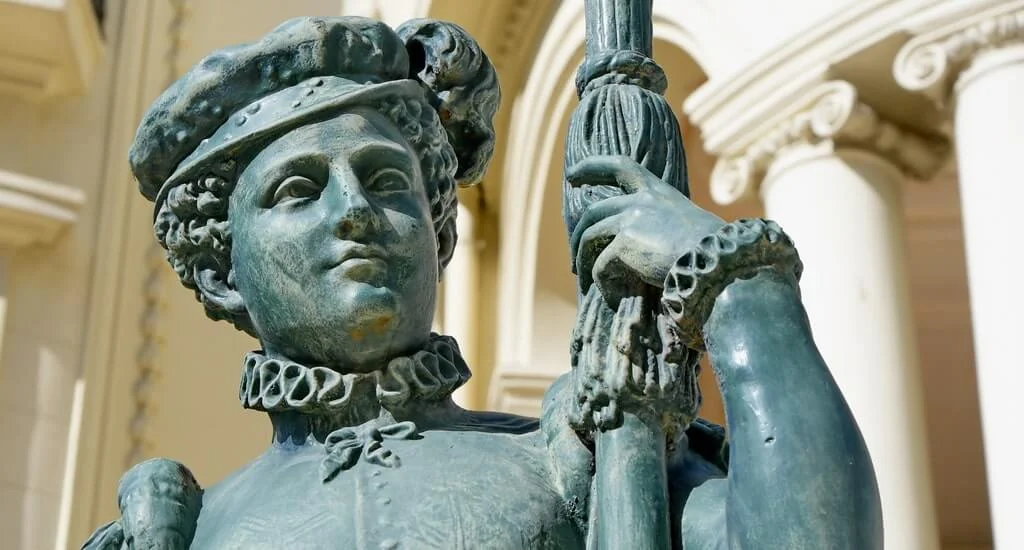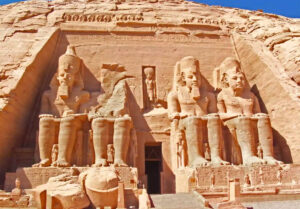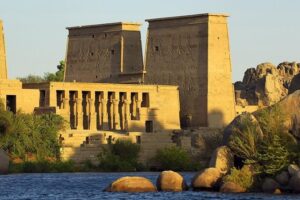Cultural Exchange in Ancient Egypt
Ancient Egypt was not a sealed-off kingdom. It was a dynamic civilization at the heart of a vast network of cultural exchange. Throughout its history, Egypt actively traded and interacted with neighboring cultures. This continuous contact enriched its art, religion, technology, and society. The most profound and enduring of these relationships was with Nubia, located to the south.
Cultural Exchange: The Nile Valley
The Nile River was a superhighway for cultural exchange. It connected Egypt to the kingdoms of Nubia in the south and the Mediterranean world in the north. This vital waterway ensured a constant flow of people, goods, and ideas. Egypt’s desire for gold, ivory, and unfamiliar animals from Sub-Saharan Africa drove its interaction with Nubia. In return, the Egyptians exported grain, linen, and manufactured goods. This trade created deep economic and social ties. Egyptians also launched military campaigns into Nubia. They aimed to control trade routes and secure resources. Yet, these campaigns also led to a significant exchange of military technology and personnel. Nubian archers, for example, were highly valued and often served in the Egyptian army.
The Influence of Nubia on Egypt
The relationship between Egypt and Nubia was a two-way street. While Egypt exerted its influence, Nubian culture left a profound mark on Egyptian civilization. The most dramatic example of Nubian influence on Egypt came during the 8th century BCE. The kingdom of Kush, with its capital at Napata, rose to power. Its rulers conquered Egypt and established the 25th Dynasty. These Black Egyptian people ruled over a unified Nile Valley. They saw themselves as guardians of true Egyptian tradition and actively worked to restore ancient temples and monuments. This period revitalized Egyptian culture and religion. Over time, Egyptian and Nubian cultures blended. Egyptian deities like Amun became the primary god in Nubia. Similarly, Nubian deities like Dedun, the god of incense, were sometimes worshipped in Egypt. Nubian art and architecture also influenced Egyptian styles, particularly in jewelry and decorative arts.
Beyond the Nile: The Broader World
Egypt’s cultural connections extended far beyond Nubia. The country was a major player in the ancient Mediterranean and Near East. Egyptians regularly traded with cities in the Levant, exchanging goods like papyrus and grain for timber and metals. This interaction led to a fusion of artistic styles. For example, some Egyptian tomb paintings show Syrian tribute bearers. Archaeological evidence shows early contact between Egypt and the Minoan civilization on Crete. Egyptian artifacts have been found on Crete, and Minoan frescos show Egyptian-inspired motifs. This connection later extended to the Mycenaeans in mainland Greece. Egypt had a profound impact on Western civilization. Greek philosophers and scholars traveled to Egypt to study. They learned about Egyptian mathematics, medicine, and astronomy. Roman culture, which later absorbed Greek traditions, was also heavily influenced. The Romans built temples in the Egyptian style and adopted Egyptian deities like Isis into their pantheon.
The Enduring Legacy of Nubian Culture
Today, the Nubian people in Egypt maintain a distinct and vibrant culture. Their heritage is a powerful example of resilience. Nubian culture is known for its hospitality and artistic expression. Nubian houses are often painted with bright colors and geometric designs. The music is distinctive, featuring unique rhythms and string instruments. The Nubian language (a group of Nilo-Saharan languages) is a crucial part of their identity. Many Nubians speak both Arabic and their native tongue. They have worked to preserve their language despite historical displacement. Their Nubian traditions and customs, such as unique marriage ceremonies and community festivals, have survived for centuries. They represent a living link to the interconnected past of the Nile Valley.
Ancient Egypt: A Crossroads of Civilizations
Cultural exchange was a driving force in ancient Egypt. From the gold-rich lands of Nubia to the bustling ports of the Mediterranean, Egypt was a cultural nexus. This exchange enriched every aspect of life, leaving a legacy that we still see today. The story of ancient Egypt is, in many ways, the story of its relationships with the world around it.











